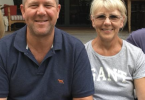Laura Hartnell’s eyes shift from left to right as she gathers her thoughts. It is as if she is searching inside her mind rather than looking outward. She stops and looks straight at me. “There’s still a real lack of tolerance in public for women’s experiences of trauma that doesn’t fit into a certain shape.” Hartnell has spent years researching female trauma. The 28-year-old PhD candidate is using feminine writing. It is a technique from feminist philosophy to explore new ways of dealing with female trauma. I sat down with Hartnell one afternoon last summer in Melbourne to discuss her work.
She began her research in the context of the MeToo (or #MeToo) movement that arose in the US in 2006. Following the revelation of multiple sexual assaults against Hollywood producer Harvey Weinstein, the movement went viral in 2017. “I think MeToo was great, but there’s still a legitimacy issue,” Hartnell told me. “You have to remember your trauma for a start.” She said the movement was born out of, and in many ways still legitimises, public instances of sexual assault. She believes different experiences could potentially be excluded. For example, she said, childhood sexual abuse that took place over many years, where events that are not well-remembered. Evidence is scarce. “There’s still a bit of fear out there around those stories that don’t fit into the box,” she said.
According to a 2020 report, almost two million Australian adults have experienced at least one instance of sexual assault since the age of 15. In 2018–19, 97 per cent of sexual assault offenders were male. A worker from the Centre Against Sexual Assault (CASA) in Melbourne told me that although men can be victims/survivors of sexual assault, it is overwhelmingly women and gender diverse people who are affected. Sue, she requested not to use her real name, works at CASA.
CASA views sexual assault as something that is driven by, and a perpetrator of, gender inequality. Sue told me women could experience trauma from sexual assault differently from men because of gender norms. “Victim/survivors like any person are conditioned by gender norms. They have a personal sense of gender identity and a personal experience with how they’ve navigated that before.”
Sue, who has a background in social work, said trauma was viewed and treated through a lens of post-traumatic stress disorder. She believes there are still some limitations to the way trauma is addressed. “Trauma can be a very biomedical framework to hold,” she told me. “Without any structural analysis behind it can be dangerous, unhelpful and serve normalised experiences of harm and recovery from experiences of harm without challenging why harm happens.” She said the workers at CASA aimed to marry a trauma-informed framework with a feminist analysis, where the latter works to hold the former to account “from its own limitations.”
Beyond the fact there is widespread sexual assault induced trauma in Australia, there is also insidious trauma. Laura Hartnell was studying the idea of insidious trauma while the MeToo movement was gaining momentum. “Insidious trauma” was coined by American psychologist Maria Root, who describes it a “traumatogenic effects of oppression that are not necessarily overtly violent or threatening to bodily well-being at the given moment but that do violence to the soul and the spirit”. In terms of women’s experiences, this can be thought of as day-to-day objectification, intimidation and sexism.
Hartnell’s interest in female trauma comes from personal experience. She describes her trauma as “an energy like nothing else…It’s a mutant, it just keeps mutating. It wants to live”. Hartnell intermittently lets out a chuckle during our conversation and I sense that is because the enormity of trauma is almost absurd.
I too am a trauma survivor. In my experience, my trauma has resurfaced many times and taken unexpected forms. It have often found it baffling and so I found myself laughing along with Hartnell while we were talking.
Through her own experience and studies into trauma, Hartnell adopted the philosophical idea of the feminine. “This just means anything that is not particularly explainable, not binary, and multitudinous,” she said. Her background in performance studies led her to wonder if artistic expression could help highlight the more tacit, unexplainable parts of trauma. The trauma that isn’t remembered well or doesn’t fit into a box. The trauma that is beyond words. This is where the idea of feminine writing came in.
One of the ways insidious trauma plays out is through traditional patriarchal language. Hartnell explained to me that patriarchal, or masculine, language is linear and straightforward in structure. It is based on logic and reason. “Feminine writing is anything that aims to make the reader feel stuff in their body rather than, or as well as, cognitively understanding something,” Hartnell said. She admits the term isn’t perfect, “but it’s what we’ve got to work with”.
In her 1975 article, The Laugh of the Medusa, French feminist philosopher Hélène Cixous says it is impossible to define a feminine writing practice because it “can never be theorised, enclosed or coded”. She argues that writing, and language, in its masculine form, has been used as part of the repression of women. “Women must write herself: must write about women and bring women to writing, from which they have been driven away as violently as from their bodies – for the same reasons, by the same law, with the same fatal goal.”
Feminine writing aims to forge a new relationship with language that attempts to come from a different place than the patriarchal language that dominates. In contrast to patriarchal language, feminine language is, according to Laura, “fragmented, playful and experiments with time and points of view”. While writing this article, I am not unaware of the irony that I am using the kind of language which is implicitly critiqued here. Still, ultimately this is a feature story, not therapy.
Trauma resides in the body. There may be fragments of conscious memory of the traumatic event/s, but the body stores somatic information. Furthermore, the Broca’s area, or the speech centre of the brain, can be ‘switched off’ when a person is experiencing trauma symptoms, which highlights the difficulty in relying on language in treatment. I can relate to this. I’m a writer and have often wanted to express the complex feelings associated with my traumatic experiences. But I often felt there were no words to capture the depths of my inner world.
In feminine writing, the body creates meaning. Cixous writes, “women are body…[m]ore body hence more writing…[f]or a long time it has been in the body that women have responded to persecution”. Sue from CASA believes feminine writing practice could provide new opportunities for trauma survivors because it brings the body into focus. “When we think about how the body is used and drawn on conceptually for feminine writing, and also the way the body is thought about through the lens of trauma, there’s a lot of opportunities for those things to be married and explored,” she said.
Hartnell extends the concept further. She argues feminine writing could help women connect to their own bodies and the bodies of other women with similar experiences. “I’m interested in how we can use language to create a kind of feminine underground involving women’s art of different kinds, that gives a meaning on a new level to the trauma that happens in women’s lives that is denied by the patriarchy,” she said.
I asked Hartnell and Sue how they think feminine writing practice could be integrated into trauma treatment. Hartnell suggested a workshop of some kind, involving meditation and body awareness practices. She emphasised this would need to occur in the presence of a trauma-informed professional. “Writing about trauma can help lessen symptoms,” she said. “It can help gain an understanding that your trauma is part of your life in a greater way. That doesn’t mean it’s ‘good’ or ‘bad, but that it has an energy that will inform your life beyond the perceived negative energy of PTSD.”
Sue said feminine writing could potentially be incorporated into other forms of narrative therapy. “Any way that someone’s marginalised experience can be given a new language, and can be honoured, is really important…We’re really sitting on the edge of this stuff. It’s exciting,” she said.
Hartnell believes the practice of feminine writing could assist in healing from trauma. She imagines there are “levels” or “planes of existence”. One is our everyday reality, and the other a kind of “feminine underground, where words are not necessary to be understood”. She said it was in this underground where trauma resides. “The reason feminine writing works so well for trauma is that they are essentially speaking the same language,” she said. “By dropping down to the other level, we can embrace more feminine ways of knowing.” For Hartnell, something happens between her and other women with similar experiences who inhabit this space. Here, women’s very existence is a source of power and creativity. She said this common experience has helped her feel less alone in her own trauma.
None of this is to say that feminine writing can offer a magic cure for trauma or that it could replace the role of informed professionals. Trauma therapy is a growing area, and much is still to be learnt about its impacts and treatment. “Language will probably always fail,” Hartnell said. “I don’t think you can ever get to something that will satisfactorily capture all of your trauma and everything it means, but I think feminine writing can bring you closer and that is really the best we can wish for.” The widespread and seemingly intractable problem of trauma is still far from understood. However, work such as this, which brings new and creative approaches, offers hope to the countless women who live with it every day.
Featured Image: StockSnap, Pixabay





[…] Winner – Sarah Liversidge, RMIT: Women’s trauma, the body and the failure of language […]